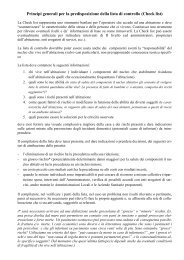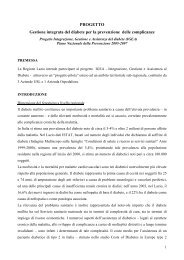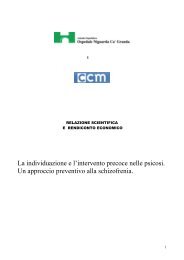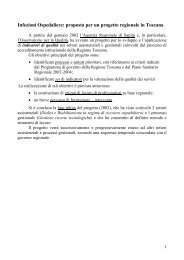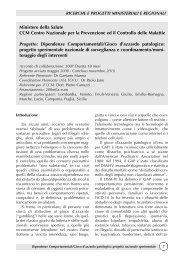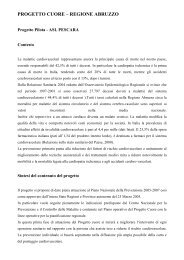Gaining health : analysis of policy development in European ...
Gaining health : analysis of policy development in European ...
Gaining health : analysis of policy development in European ...
Create successful ePaper yourself
Turn your PDF publications into a flip-book with our unique Google optimized e-Paper software.
• Of the countries respond<strong>in</strong>g <strong>in</strong> 2005/2006, 71% reported<br />
that they had national targets for chronic disease<br />
prevention and control.<br />
• There is an <strong>in</strong>creas<strong>in</strong>g tendency for hav<strong>in</strong>g a national<br />
action plan for tobacco control, diabetes, heart disease<br />
and cancer. The proportion <strong>of</strong> countries respond<strong>in</strong>g to<br />
both surveys that had such an action plan <strong>in</strong>creased by<br />
40%, 14%, 13% and 17%, respectively, over the five-year<br />
period.<br />
• Almost two thirds <strong>of</strong> the countries had become contract<strong>in</strong>g<br />
parties to the WHO FCTC and 24% were<br />
already under way with plans for implementation.<br />
• Of the countries respond<strong>in</strong>g <strong>in</strong> 2005/2006, 92%<br />
reported that they <strong>in</strong>cluded chronic diseases <strong>in</strong> their annual<br />
<strong>health</strong> reports.<br />
• Of the 30 countries respond<strong>in</strong>g to both surveys, the<br />
proportion hav<strong>in</strong>g a rout<strong>in</strong>e surveillance system for<br />
chronic diseases <strong>in</strong>creased 10% between 2000/2001<br />
and 2005/2006 to 84%.<br />
• Most countries respond<strong>in</strong>g <strong>in</strong> 2005/2006 reported<br />
hav<strong>in</strong>g national or prov<strong>in</strong>cial studies or surveys <strong>of</strong> the<br />
risk factors tobacco use, un<strong>health</strong>y diet, physical activity<br />
and alcohol consumption (87%, 84%, 82% and 84%,<br />
respectively).<br />
• Nearly two thirds <strong>of</strong> the countries respond<strong>in</strong>g <strong>in</strong><br />
2005/2006 had established a national demonstration<br />
programme for <strong>in</strong>tegrated chronic disease prevention<br />
and control.<br />
• A large proportion <strong>of</strong> respond<strong>in</strong>g countries <strong>in</strong><br />
2005/2006 reported hav<strong>in</strong>g national protocols, guidel<strong>in</strong>es<br />
or standards for hypertension, diabetes, heart<br />
disease and cancer (79%, 82%, 74% and 82%, respectively).<br />
• The proportion <strong>of</strong> countries respond<strong>in</strong>g to both<br />
surveys that had a specific budget for implement<strong>in</strong>g a<br />
national <strong>policy</strong> or strategy for chronic disease prevention<br />
and control rose from 50% <strong>in</strong> 2000/2001 to 73% <strong>in</strong><br />
2005/2006.<br />
The ma<strong>in</strong> characteristics <strong>of</strong> NCD policies, programmes and<br />
legislation <strong>in</strong> place <strong>in</strong> <strong>European</strong> countries, based on the replies<br />
submitted by 38 countries, are summarized <strong>in</strong> Table 1.<br />
Thus, at the time <strong>of</strong> the <strong>development</strong> and launch <strong>of</strong> the<br />
<strong>European</strong> NCD Strategy, the NCD <strong>policy</strong> field <strong>in</strong> <strong>European</strong><br />
countries already appears to have been rich <strong>in</strong> “vertical”<br />
issue-specific national policies and programmes as well as<br />
more “horizontal” or “umbrella” policies and programmes<br />
relevant to chronic disease prevention and control as a<br />
whole.<br />
The results <strong>of</strong> the survey <strong>in</strong>dicate clearly the opportu nities<br />
but also the limits <strong>of</strong> such a quantitative approach.<br />
While the survey had measured the quantity <strong>of</strong> policies and<br />
programmes present <strong>in</strong> a country, it could not <strong>in</strong>dicate their<br />
quality or their success <strong>in</strong> implementation, or expla<strong>in</strong> how<br />
or why they had evolved <strong>in</strong> such a way over time and their<br />
<strong>in</strong>terrelationships. The case studies presented <strong>in</strong> Chapter<br />
IV aim to provide deeper, more ref<strong>in</strong>ed qualitative data and<br />
<strong>in</strong>formation on the assessment <strong>of</strong> Member States’ policies<br />
and capacities to respond to NCD.<br />
<strong>Ga<strong>in</strong><strong>in</strong>g</strong> <strong>health</strong><br />
The WHO Regional Committee for Europe, at its fiftyfourth<br />
session <strong>in</strong> 2004, while acknowledg<strong>in</strong>g the extensive<br />
work and experience already exist<strong>in</strong>g <strong>in</strong> the <strong>European</strong><br />
Region, po<strong>in</strong>ted out the lack <strong>of</strong> and need for a strategy for<br />
NCD prevention and control <strong>in</strong> Europe. Such a strategy<br />
needed to take an <strong>in</strong>tegrated approach across the cont<strong>in</strong>uum<br />
<strong>of</strong> <strong>health</strong> promotion, disease prevention, rehabilitation<br />
and <strong>health</strong> care, and should draw on Member States’ exist<strong>in</strong>g<br />
relevant commitments, such as the various resolutions<br />
alluded to above on risk factors and determ<strong>in</strong>ants. For such<br />
an ambitious strategy and complex task, there then began<br />
an extensive consultation process with countries, experts,<br />
nongovernmental organizations (NGOs) and other stakeholders<br />
for its <strong>development</strong>.<br />
Chapter 2<br />
9<br />
History and context <strong>of</strong> policies to tackle NCD



